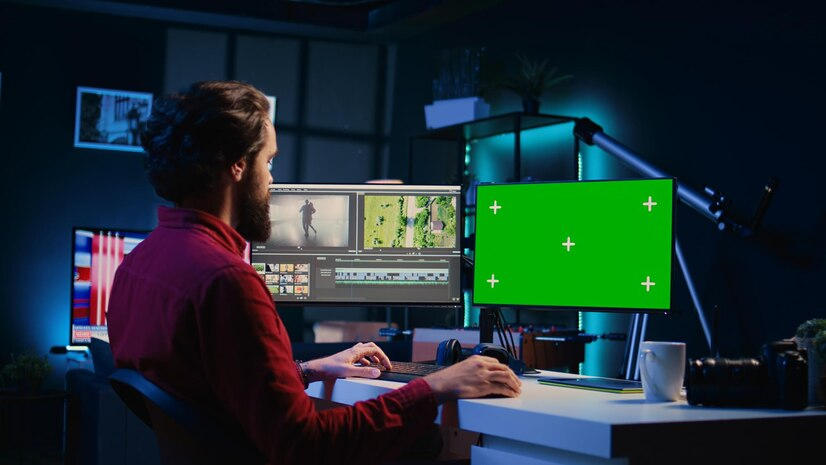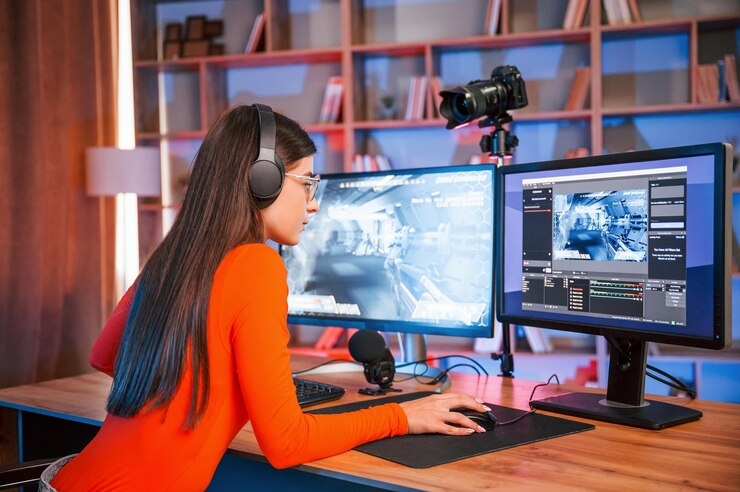At its core, editing involves cutting and assembling video clips and audio flows to create a finished product that is visually appealing and engaging for the audience.
This process is not only about trimming unwanted parts or correcting colours; it is about transforming raw footage into a piece of art that feels emotionally connected. Video editors use specialised software to arrange scenes, integrate sound, and apply special effects that enhance the storytelling.
The importance of video editing extends beyond just making a video look good; it plays a critical role in ensuring that the video content effectively communicates the intended message to the target audience.
What Is the Main Purpose of Video Editing

The main purpose of video editing is to manipulate video footage to enhance the quality and impact of the final product. This process serves multiple functions: it helps to tell a story, convey specific messages, engage viewers, and evoke emotions.
Effective editing maximises the power of visual storytelling, making it a powerful tool for film and video production. By carefully selecting shots, arranging scenes, and syncing audio, video editors craft experiences that can inform, entertain, or persuade an audience.
Editing is not just about assembling footage; it’s about creating a rhythm and flow that feels seamless and natural, ensuring that the audience remains absorbed and connected throughout the viewing experience. Whether for a corporate video, a marketing campaign video, or a music video, editing helps achieve a polished look that aligns with the creator’s vision and the audience’s expectations.
The Role of Video Editing in Film and Video Production

Video editing is fundamental in film and video production, shaping the final outcome of projects across various genres, including television shows, video advertisements, and feature films. This stage of production, known as the post-production process, is where all the elements of the film—such as raw footage, sound, and special effects—are compiled and woven together to form the final product.
The skills of video editors are crucial here, as they select the best video clips, adjust the pacing, and ensure continuity between various shots. Professional video editing services are often employed to ensure that the film or video meets industry standards of video quality and storytelling.
The editing process also involves tailoring the content to the preferences and expectations of the intended audience, making it one of the most important jobs in the production of visual media.
Video Editing Software: Tools That Make It Happen

Video editing software is essential in transforming raw footage into polished, professional quality videos. Tools like Adobe Premiere and Avid Media Composer are among the editing software used by video editors to cut scenes, integrate sound design, and apply special effects that enhance the storytelling process.
These programs provide a variety of editing tools that make it possible to adjust video quality, synchronise audio flows, and manage various shots and clips within a project. The right software can make the editing process more efficient, allowing editors to manipulate large amounts of footage and create visually appealing final products.
As technology advances, these software solutions continue to evolve, offering more sophisticated features that help video editors achieve the desired outcomes for their projects, whether they are music videos, corporate videos, or video advertisements.
The Workflow: From Raw Footage to Polished Edits

The journey from raw footage to polished edits is a detailed process that involves several stages of video editing. Initially, the video editor collects all the footage and scenes shot during the production phase. Using video editing software, they begin to piece together the story, focusing on continuity, pacing, and the overall flow of the video.
The importance of this editing stage cannot be overstated as it directly influences the video’s ability to engage the audience. Throughout this process, the editor may repeatedly adjust clips, refine audio, and apply colour correction to enhance visual and audio quality.
The final steps often involve adding music, voice overs, and any necessary special effects to ensure that the video meets the target audience’s expectations and delivers a compelling narrative.
Professional Video Editing Services

For businesses and filmmakers looking to ensure their videos make a significant impact, professional video editing services are invaluable. These services provide access to skilled video editors who bring extensive video editing skills and experience to the table.
They can handle everything from simple edits to complex visual and sound enhancements, ensuring that the final product aligns with the client’s vision and the film industry’s standards. Professional services are particularly important when creating video content that aims to inform, advertise, or entertain a large audience.
By outsourcing video editing to experts, creators can focus more on content creation and less on the technical aspects of post-production, securing a better quality and more effective videos that truly resonate with viewers.
Key Skills in Video Editing

Developing strong video editing skills is essential for anyone looking to make a mark in video production. These skills go beyond just knowing how to use video editing software; they encompass understanding the rhythm and timing that make a story engaging and compelling.
Video editors must also have a keen eye for detail to ensure that every scene, shot, and clip contributes effectively to the overarching narrative. This involves a deep understanding of various editing tools and techniques such as cutting, transitions, and layering effects which are crucial for creating professional quality videos.
Additionally, video editors need to adapt their style to suit different types of video content, from corporate videos to music videos, ensuring that each video achieves its intended impact on the target audience. Mastering these skills is fundamental in the film and video production industry, where the quality of editing can make or break the success of a project.
Special Effects and Sound Design in Editing

In the realm of video editing, special effects and sound design play pivotal roles in enhancing the overall impact of video content. Effective use of special effects can transform simple video clips into visually striking scenes that captivate the audience.
Whether it’s adding explosions in an action scene or subtle visual enhancements in a corporate video, the right effects can significantly boost the visual appeal of a video. Similarly, sound design is crucial in video editing as it involves choosing and editing audio tracks that complement the visual elements.
Good sound design ensures that music, voice-overs, and sound effects are harmoniously blended to enhance the storytelling experience. These elements are critical during the post-production process, where editors strive to create a final product that resonates emotionally with viewers, often making the difference in how the story is perceived.
Editing for Different Types of Videos

Editing techniques can vary significantly depending on the type of video being produced. For instance, editing a marketing campaign video involves pacing the content to maintain viewer interest and strategically placing calls to action.
In contrast, editing a music video might focus more on aligning the visuals with the beat of the music and creating a dynamic rhythm. Corporate videos require a different approach, as they must convey key messages clearly and professionally, often incorporating brand elements consistently throughout the video.
Video advertisements, on the other hand, need to be particularly engaging and concise, designed to capture attention quickly and effectively. Understanding these nuances is crucial for video editors as they apply their video editing skills to different projects, ensuring that each video is edited in a way that best suits its specific purpose and target audience.
The Post Production Process

The post-production process is a critical stage in video production where all elements of a film or video are assembled to create the final product. This stage involves various key activities such as editing videos, integrating sound design, and adding special effects, which all contribute to the overall quality and impact of the video.
Professional video editing services play a significant role here, ensuring that every scene, shot, and audio track aligns perfectly to deliver a cohesive and engaging story. Video editors use advanced editing software to refine video clips, correct colours, and enhance audio quality. Their skills ensure that the transitions between shots are smooth and that the final video resonates with the target audience.
This process is not just about piecing together different parts of footage; it’s about creating a product that effectively communicates the intended message and evokes the desired emotional response from viewers.
Marketing and Video Content

In the realm of digital marketing, video content plays a pivotal role in capturing audience attention and conveying messages powerfully and succinctly. Video editing is crucial in crafting marketing campaign videos that not only look professional but also are strategically designed to engage the target audience and prompt them to take action.
Through careful editing, video editors can emphasise key points, highlight product features, and create a narrative that aligns with the marketing goals. These videos often feature a mix of direct appeals, engaging visuals, and compelling stories that help brands connect with their audience on a deeper level.
Whether it’s a short video advertisement or a comprehensive corporate video, the editing process ensures that each piece of video content is optimised for maximum impact, making it an essential tool for successful marketing campaigns.
Technology and Software Solutions in Video Editing

The evolution of technology has greatly enhanced the capabilities and efficiency of video editing. Modern video editing software like Adobe Premiere and Avid Media Composer provides video editors with powerful tools that make it possible to achieve high-quality results with less effort and more creativity.
These software solutions offer features like multi-track editing, special effects libraries, and advanced colour correction tools that allow editors to manipulate footage in intricate ways. Additionally, new technology solutions continue to emerge, offering even more advanced capabilities such as AI-driven editing features, which can automatically cut scenes or adjust audio levels, further streamlining the editing process.
These advancements not only improve the quality of videos produced but also enable video editors to experiment with new styles and techniques, pushing the boundaries of digital storytelling.
The Art of Digital Storytelling

Digital storytelling through video content is a powerful tool that allows creators to connect with their audience on an emotional level. Effective video editing is essential in this process, as it helps to weave various shots and scenes into a cohesive story that captures and retains the viewer’s attention.
The role of video editors is crucial in determining how effectively a video conveys its message and evokes emotional responses. Using editing software like Adobe Premiere, video editors manipulate footage, adjust timing, add music, and integrate voice-overs to enhance the narrative’s impact. This creative process goes beyond mere technical skills; it involves an understanding of the audience’s psychology and the elements that make a story compelling.
Digital storytelling is especially significant in sectors like marketing, education, and entertainment, where the goal is to create content that not only informs but also inspires and engages. As video continues to be a dominant medium in digital communication, the skills of video editors become increasingly important in crafting stories that are not only heard but also felt and remembered.
Conclusion
Understanding the importance of video editing is key to appreciating how much work goes into creating professional quality videos that we watch every day, from television shows to online courses. Video editing is not just about cutting and combining clips; it’s about shaping raw footage into something that can inform, entertain, and inspire an audience.
It requires a deep understanding of the film and video production process, a skilled hand in manipulating digital tools, and a creative mind to see beyond the footage itself. The main purpose of video editing is to refine the video content to ensure it achieves its intended purpose, whether that’s to sell a product, educate an audience, or tell a moving story.


